International Journal of Information Technology and Computer Science @ijitcs
Статьи журнала - International Journal of Information Technology and Computer Science
Все статьи: 1254
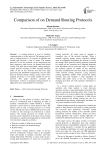
Comparison of on Demand Routing Protocols
Статья научная
A routing protocol is used to facilitate communication in ad hoc network. The primary goal of such a routing protocol is to provide an efficient and reliable path between a pair of nodes. The routing protocols for ad hoc network can be categorized into three categories: table driven, on demand and hybrid routing. The table driven and hybrid routing strategies require periodic exchange of hello messages between nodes of the ad hoc network and thus have high processing and bandwidth requirements. On the other hand on demand routing strategy creates routes when required and hence is very much suitable for ad hoc network. This paper therefore examines the performance of three on demand routing protocols at application layer using QualNet-5.01 simulator.
Бесплатно
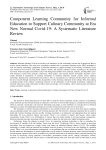
Статья научная
Informal education will be successful as an alternative for the community because not all people are able to receive formal education. This study uses a qualitative method with a systematic literature review (SLR) technique to look for learning community components in informal education to support learning in the culinary community in the new normal era of Covid-19. The author collects, studies, and analyzes reference sources according to the specified keywords. Found 53 papers from 2002 to 2021 with background authors from academia, industry, and the public sector with reference sources from journals, conferences, white papers, and research reports. Systematic literature review results obtained 6 components of learning community in informal education, namely content, forum, method, technology, figure/layout, and human/social resources. The six components as a reference and the author's first step in the next research through searching for the characteristics of the learning community in the culinary field, then making a learning model of the culinary community. Because of the importance of the learning community component in informal education to help community members share knowledge, solve problems, share common goals and interests among community members.
Бесплатно
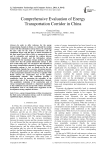
Comprehensive Evaluation of Energy Transportation Corridor in China
Статья научная
In order to offer reference for the energy transportation channels in future, we evaluated the existing system with the information entropy theory. By calculating the base value for the scale of construction and the equilibrium degree with the data of annual investment in the fixed assets from 1986 to 2010, we measured the scale and its rationality, and analyzed the relation between transportation channels and the information entropy combined with the maximum entropy methods. Empirical results show that the partial information entropy Si still have certain rising space. We can improve the rationality of the energy transportation channels by improving the partial information entropy Si. And we should not let the rail transportation channels have excessive investment growth, and then secondly transfer some of the highway investment to the transportation channels of waterway or pipeline while finally advance the construction step of the pipeline transportation channels. This conclusion provides a quantitative basis for measuring the rationality of the construction scale of the energy transportation channels. The quantitative evaluation of the construction scale of energy transportation channels is a important supplement to the traditional research and provide evidence for further development. And we can obtain more suggestions on the development strategy emphasis in future.
Бесплатно
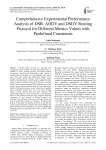
Статья научная
A Mobile Adhoc Network is a multi-hop self-configuring network without any fixed infrastructure. Due to mobility of nodes, dynamic topology and highly dynamic environment, designing and implementing stable routing in Mobile Ad-hoc Networking is a major challenge and a critical issue. This paper analyses the performance analysis of on demand routing protocol, Dynamic Source Routing (DSR), Adhoc on Demand Distance Vector Routing (AODV) and table driven protocol, Destination-Sequenced Distance Vectoring (DSDV) using a network simulator NS2. Different types of test scenario have designed with fixed number of nodes but varying mobility. Different performance metric values like, throughput, delay, normalized network load, end to end delay, dropped packets, packets delivery ratio have been observed. The experimental results have been analysed and recommendation based on the obtained results has been proposed about the significance of each protocol in different scenarios and situations. The simulation results show that both protocols are good in performance in their own categories. We believe that findings of this paper will help the researcher to find the best protocol under predefined condition with varied mobility. We believe that this research will help the researcher to identify and further investigate any particular metrics value of AODV, DSR and DSDV.
Бесплатно
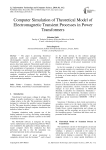
Статья научная
The paper is presenting theoretical analytical model and computer simulation of electromagnetic transient process in a transformer. Transformer parameters in a selected transitional process have been analyzed. Theoretical model refers to an energetic transformer with concentrated parameters with consideration of parameters of mutual inductance M. Simulation was performed on a personal computer using the software program MATLAB SIMULINK. The computer simulation confirmed the possibility of transitional process analysis in transformer’s windings with concentrated parameters.
Бесплатно

Confidence Analysis of a Solo Sign-On Device for Distributed Computer Networks
Статья научная
Solo sign-on (SSO) is a new authentication mechanism that enables a legal user with a single credential to be authenticated by multiple service providers in a distributed computer network. Recently, a SSO scheme proposed and claimed its security by providing well organized security arguments. But their scheme is actually insecure as it fails to meet credential privacy and soundness of authentication. Specifically, we present two impersonation attacks i.e., credential recovering attack and impersonation attack without credentials. So we propose a more authentication scheme that overcomes these attacks and flaws by make use of efficient verifiable encryption of RSA signatures. We promote the formal study of the soundness of authentication as one open problem.
Бесплатно
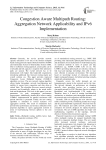
Congestion Aware Multipath Routing: Aggregation Network Applicability and IPv6 Implementation
Статья научная
Currently, the service provider network capacity utilization is low due to the shortest multipath based routing protocols Opens Shortest Path First (OSPF) and Intermediate System-to-Intermediate System (ISIS). Due to inefficient routing approach, certain paths can be overloaded and link capacity is required while alternative paths are unused. The overall network has to be dimensioned with higher link bandwidth requirements introducing additional line, linecard, routing engine and overall solution cos. This paper provides improved Congestion Aware Multipath Routing (CAMRv2) algorithm overview. The new network routing algorithm allows higher throughput, network load-balancing and stability to ensure lower congestion and data drop on critical links. The algorithm discovers unused network resources and dynamically adapts to the actual traffic load and displacement. The focus in this paper is on new parameters for path computation performance improvement. Additionally, detailed IPv6 source routing CAMRv2 implementation for parallel coexistence with present networks is presented. Finally, the new routing algorithm is simulated in several scenarios over aggregation network. The result of simulations have proved better performance and resource utilization of the proposed algorithm in sparse aggregation network in terms of load-balancing between uplinks to the core network.
Бесплатно
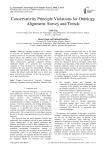
Conservativity Principle Violations for Ontology Alignment: Survey and Trends
Статья научная
Ontology matching techniques are a solution to overcome the problem of interoperability between ontologies. However, the generated mappings suffer from logical defects that influence their usefulness. In this paper we present a detailed analysis of the problem so-called conservativity principle; alignment between ontologies should never generate new knowledge compared to those generated by reasoning solely on ontologies. We also study the sub-problems; Ontology change and Satisfiability preservation problems and compare the related works and their way to detect and repair conservativity principle. At the end we present a set of open research issues.
Бесплатно
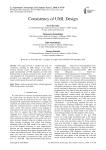
Статья научная
The paper presents a method and tools for consistency checking in UML design of an object-oriented software system. The proposed method uses graph representation of UML diagrams and first-order predicate logic to specify consistency rules mostly on the cross-diagram level. Classification of consistency rules is presented. Two approaches to implementation of con-sistency checking are discussed and compared.
Бесплатно
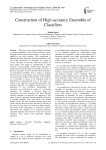
Construction of High-accuracy Ensemble of Classifiers
Статья научная
There have been several methods developed to construct ensembles. Some of these methods, such as Bagging and Boosting are meta-learners, i.e. they can be applied to any base classifier. The combination of methods should be selected in order that classifiers cover each other weaknesses. In ensemble, the output of several classifiers is used only when they disagree on some inputs. The degree of disagreement is called diversity of the ensemble. Another factor that plays a significant role in performing an ensemble is accuracy of the basic classifiers. It can be said that all the procedures of constructing ensembles seek to achieve a balance between these two parameters, and successful methods can reach a better balance. The diversity of the members of an ensemble is known as an important factor in determining its generalization error. In this paper, we present a new approach for generating ensembles. The proposed approach uses Bagging and Boosting as the generators of base classifiers. Subsequently, the classifiers are partitioned by means of a clustering algorithm. We introduce a selection phase for construction the final ensemble and three different selection methods are proposed for applying in this phase. In the first proposed selection method, a classifier is selected randomly from each cluster. The second method selects the most accurate classifier from each cluster and the third one selects the nearest classifier to the center of each cluster to construct the final ensemble. The results of the experiments on well-known datasets demonstrate the strength of our proposed approach, especially applying the selection of the most accurate classifiers from clusters and employing Bagging generator.
Бесплатно
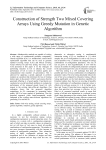
Construction of Strength Two Mixed Covering Arrays Using Greedy Mutation in Genetic Algorithm
Статья научная
Metaheuristic methods are capable of solving a wide range of combinatorial problems competently. Genetic algorithm (GA) is a metaheuristic search based optimization algorithm that can be used to generate optimal Covering Arrays (CAs) and Mixed Covering Arrays (MCAs) for pair-wise testing. Our focus in the work presented in this paper is on the strategies of performing mutation in GA to enhance the overall performance of GA in terms of solution quality and computational time (number of generations). This is achieved by applying a greedy approach to perform mutation at a position that minimizes the loss of existing distinct pairs in the parent CA/MCA and ensures that the generated offspring is of good quality. Experiments are conducted on several benchmark problems to evaluate the performance of the proposed greedy based GA with respect to the existing state-of-the-art algorithms. Our evaluation shows that the proposed algorithm outperforms its GA counterpart by generating better quality MCA in lesser number of generations. Also the proposed approach yields better/comparable results compared to the existing state-of-the-art algorithms for generating CAs and MCAs.
Бесплатно
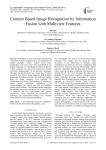
Content Based Image Recognition by Information Fusion with Multiview Features
Статья научная
Substantial research interest has been observed in the field of object recognition as a vital component for modern intelligent systems. Content based image classification and retrieval have been considered as two popular techniques for identifying the object of interest. Feature extraction has played the pivotal role towards successful implementation of the aforesaid techniques. The paper has presented two novel techniques of feature extraction from diverse image categories both in spatial domain and in frequency domain. The multi view features from the image categories were evaluated for classification and retrieval performances by means of a fusion based recognition architecture. The experimentation was carried out with four different popular public datasets. The proposed fusion framework has exhibited an average increase of 24.71% and 20.78% in precision rates for classification and retrieval respectively, when compared to state-of-the art techniques. The experimental findings were validated with a paired t test for statistical significance.
Бесплатно
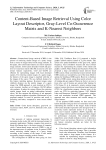
Статья научная
Content-based image retrieval (CBIR) is the process of retrieving similar images of a query image from a source of images based on the image contents. In this paper, color and texture features are used to represent image contents. Color layout descriptor (CLD) and gray-level co-occurrence matrix (GLCM) are used as color and texture features respectively. CLD and GLCM are efficient for representing images with local dominant regions. For retrieving similar images of a query image, the features of the query image is matched with that of the images of the source. We use cityblock distance for this feature matching purpose. K-nearest images using cityblock distance are the similar images of a query image. Our CBIR approach is scale invariant as CLD is scale invariant. Another set of features, GLCM defines color patterns. It makes the system efficient for retrieving similar images based on spatial relationships between colors. We also measure the efficiency of our approach using k-nearest neighbors algorithm. Performance of our proposed method, in terms of precision and recall, is promising and better, compared to some recent related works.
Бесплатно
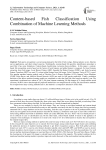
Content-based Fish Classification Using Combination of Machine Learning Methods
Статья научная
Fish species recognition is an increasing demand to the field of fish ecology, fishing industry sector, fisheries survey applications, and other related concerns. Traditionally, concept-based fish specifies identification procedure is used. But it has some limitations. Content-based classification overcomes these problems. In this paper, a content-based fish recognition system based on the fusion of local features and global feature is proposed. For local features extraction from fish image, Local Binary Pattern (LBP), Speeded-Up Robust Feature (SURF), and Scale Invariant Feature Transform (SIFT) are used. To extract global feature from fish image, Color Coherence Vector (CCV) is used. Five popular machine learning models such as: Decision Tree, k-Nearest Neighbor (k-NN), Support Vector Machines (SVM), Naïve Bayes, and Artificial Neural Network (ANN) are used for fish species prediction. Finally, prediction decisions of the above machine learning models are combined to select the final fish class based on majority vote. The experiment is performed on a subset of ‘QUT_fish_data’ dataset containing 256 fish images of 21 classes and the result (accuracy 98.46%) shows that though the proposed method does not outperform all existing fish classification methods but it outperforms many existing methods and so, the method is a competitive alternative in this field.
Бесплатно
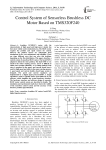
Control System of Sensorless Brushless DC Motor Based on TMS320F240
Статья научная
A brushless DC(BLDC) motor with the characteristics of high speed and high power density has been more widely used in industrial area. The BLDC motor requires the position and speed sensors for control. However the position sensors are undesirable from standpoints of size, cost, maintenance and reliability. There are some different ways that can solve this problem, depending on the flux distribution. This paper describes a control system of sensorless BLDC motor. The back-EMF is adopted to detect the rotor position. The back-EMF is very small in the motor starting process, and it is difficult to obtain rotor position efficiently. A re-setting method of the rotor is proposed in the paper, and current closed loop is used for high-speed and safety in the motor starting process. A good speed and current double closed loops system is designed. The speed and current regulators are implemented by a digital signal processor(DSP). A simple algorithm is used to calculate motor speed indirectly by the software, which simplifies the system hardware structure. The hardware structure and software design of sensorless BLDC motor control system are described in details. The simulation and experimental results have shown the validity of the sensorless control system and the accuracy of the detective position signal obtained.
Бесплатно
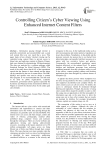
Controlling Citizen’s Cyber Viewing Using Enhanced Internet Content Filters
Статья научная
Information passing through internet is generally unrestricted and uncontrollable and a good web content filter acts very much like a sieve. This paper looks at how citizens’ internet viewing can be controlled using content filters to prevent access to illegal sites and malicious contents in Nigeria. Primary data were obtained by administering 100 questionnaires. The data was analyzed by a software package called Statistical Package for Social Sciences (SPSS). The result of the study shows that 66.4% of the respondents agreed that the internet is been abused and the abuse can be controlled by the use of content filters. The PHP, MySQL and Apache were used to design a content filter program. It was recommended that a lot still need to be done by public organizations, academic institutions, government and its agencies especially the Economic and Financial Crime Commission (EFCC) in Nigeria to control the internet abuse by the under aged and criminals.
Бесплатно
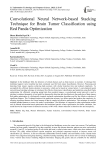
Статья научная
In the healthcare field, the detection of critical diseases such as brain tumors is essential. A technique like traditional support vector machine has been commonly used for brain tumor classification. However, Processing and detecting brain tumors requires achieving high accuracy with shorter detection time and reduced complexity. To accomplish this, efficient feature selection is necessary, which can be based on various factors. A convolutional neural network-based stacking technique is introduced for effective brain tumor classification and prediction using Red Panda optimization. By efficiently extracting spatial data from medical images, a convolutional neural network is used in stacking to enhance thecapacity of our model for abnormality detection and classification in the prediction of brain tumors. Red panda optimization is a biologically inspired stochastic optimization algorithm used for the effective selection of significant features. This Technique improves the prediction accuracy in a shorter period and reduces the complexity by selecting significant features for a huge amount of data by employing effective optimization. This technique is tested on multiple standard datasets to assess our model’s performance. Our technique is compared to other optimization models such as Mutual information-based optimization and traditional particle swarm optimization for further validation. Our model showed an improvement in detection accuracy to 98% with a better reduction in detection time and complexity.
Бесплатно

Cost Minimized PSO based Workflow Scheduling Plan for Cloud Computing
Статья научная
Cloud computing is a collection of heterogeneous virtualized resources that can be accessed on-demand to service applications. Scheduling large and complex workflows becomes a challenging issue in cloud computing with a requirement that the execution time as well as cost incurred by using a set of heterogeneous cloud resources should be minimizes simultaneously. In this paper, we have extended our previously proposed Bi-Criteria Priority based Particle Swarm Optimization (BPSO) algorithm to schedule workflow tasks over the available cloud resources under given the deadline and budget constraints while considering the confirmed reservation of the resources. The extended heuristic is simulated and comparison is done with state-of-art algorithms. The simulation results show that extended BPSO algorithm also decreases the execution cost of schedule as compared to state-of-art algorithms under the same deadline and budget constraint while considering the exiting load of the resources too.
Бесплатно
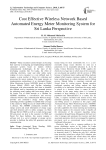
Статья научная
Many researchers and developers are focusing their curiosity on designing and implementing industrial automated systems based on modern wireless communication technologies. In the most of the developing countries like Sri Lanka, the effort of collecting electricity, water and other utility meter reading of every consumer is a very difficult task. It requires a great number of labors for collecting and processing the meters readings. This paper presents an implementation methodology of an Automated Energy Meter Monitoring System (AEMMS) based on Global System Mobile (GSM) and Zig-Bee technology incorporate with microcontroller that aims to diminish this difficult task by introducing an automated process for collecting meter reading data from energy meter in Sri Lanka. Use of GSM network as a medium for AEMMS establishes a cost-effective and two-way connected wireless data communication between energy provider and consumer’s energy meter. Zig-Bee technology provides capability to establish fully coverage in the country by filling the area in which GSM coverage is absence. The AEMMS continuously monitors the energy system and sends information of energy usage and theft detection alert to utility company via Short Message Service (SMS) as well as it sends energy usage bill and power cut alert to the customer via SMS and Email. For these facilities, this system contains a software tool in a server computer at energy service provider to facilitate the utility bill generation and data communication.
Бесплатно

Coupling Complexity Metric: A Cognitive Approach
Статья научная
Analyzing object – oriented systems in order to evaluate their quality gains its importance as the paradigm continues to increase in popularity. Consequently, several object- oriented metrics have been proposed to evaluate different aspects of these systems such as class coupling. This paper presents a new cognitive complexity metric namely cognitive weighted coupling between objects for measuring coupling in object- oriented systems. In this metric, five types of coupling that may exist between classes: control coupling, global data coupling, internal data coupling, data coupling and lexical content coupling are consider in computing CWCBO.
Бесплатно

